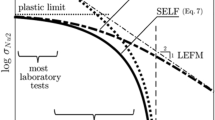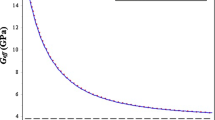Abstract
It is shown that if the bilinear stress-separation law of the cohesive crack model is identified from the complete softening load-deflection curve of a notched human bone specimen of only one size, the problem is ill-conditioned and the result is non-unique. The same measured load-deflection curve can be fitted with values of initial fracture energy and tensile strength differing, respectively, by up to 100 and 72.4 % (of the lower value). The material parameters, however, give very different load-deflection curves when the specimen is scaled up or down significantly. This implies that the aforementioned non-uniqueness could be avoided by testing human bone specimens of different sizes. To demonstrate it, tests of notched bovine bone beams of sizes in the ratio of 1:\(\sqrt{6}\):6 are conducted. To minimize random scatter, all the specimens are cut from one and the same bovine bone, even though this limits the number of specimens to 8. A strong size effect is found, but an anomaly in the size effect data trend is obtained, probably due to random scatter and too small a number of specimens. Further it is shown that the optimum range of size effect testing based on Bažant’s size effect law approximately coincides with the size range of beams that can be cut from one bovine bone. By size effect fitting of previously published data on human bone, it is shown that the optimum size range calls for beam depths under 10 mm, which is too small for the standard equipment of mechanics of materials labs and would require a special miniaturized precision equipment.













Similar content being viewed by others
References
Bao G, Ho S, Suo Z, Fan B (1992) The role of material orthotropy in fracture specimens for composites. Int J Solids Struct 29(9):1105–1116
Barenblatt GI (1959) The formulation of equilibrium cracks during brittle fracture, general ideas and hypothesis, axially symmetric cracks. Prikl Mat Mech 23(3):434–444
Barenblatt GI (1962) The mathematical theory of equilibrium of cracks in brittle failure. Adv Appl 7:55–129
Bažant ZP (1984) Size effect in blunt fracture: concrete, rock, metal. J Eng Mech ASCE 110(4):518–535
Bažant ZP (1997) Scaling theory for quasibrittle structural failure. Proc Natl Acad Sci USA 101(37):13400–13407
Bažant ZP (2005) Scaling of structural strength. Elsevier, London
Bažant ZP, Becq-Giraudon E (1999) Effects of size and slenderness on ductility of fracturing structures. J Eng Mech ASCE 125(3):331–339
Bažant ZP, Kazemi MT (1990) Determination of fracture energy, process zone length, and brittleness number from size effect, with application to rock and concrete. Int J Fract 44:111–131
Bažant ZP, Kazemi MT (1991) Size effect on diagonal shear failure of beams without stirrups. ACI Struct J 88(3):268–276
Bažant ZP, Planas J (1998) Fracture and size effect in concrete and other quasibrittle materials. CRC Press, Boca Raton
Bažant ZP, Oh B-H (1983) Crack band theory for fracture of concrete. Mater Struct 16(3):155–177
Bažant ZP, Yu Q (2011) Size-effect testing of cohesive fracture parameters and nonuniqueness of work-of-fracture method. J Eng Mech ASCE 137(8):580–588
Cusatis G, Schauffert EA (2009) Cohesive crack analysis of size effect. Eng Fract Mech 76(14):2163–2173
Guinea GV, Planas J, Elices M (1992) Measurement of the fracture energy using 3-point bend tests. 1. Influence of experimental procedures. Int J Fract 138:101–137
Hillerborg A, Modéer M, Petersson PE (1976) Analysis of crack formation and crack growth in concrete by means of fracture mechanics and finite elements. Cem Concr Res 6(6):773–782
Irwin GR (1958) Fracture. In: Flügge (ed) Handbuch der Physik. Springer, Berlin, vol 6, pp 551–590
Nakayama J (1965) Direct measurement of fracture energies of brittle heterogeneous materials. J Am Ceram Soc 48(11):583
Nalla RK, Kruzic JJ, Ritchie RO (2004) On the origin of the toughness of mineralized tissue: micro cracking or crack bridging? Bone 34(5):790–8
Nalla RK, Kruzic JJ, Kinney JH, Ritchie RO (2005) Mechanistic aspects of fracture and R-curve behavior in human cortical bone. Biomaterials 26(2):217–31
Petersson PE (1981) Crack growth and development of fracture zones in plain concrete and similar materials. Report TVBM-1006 (Dissertation), Div. of Building Materials, Lund Inst. of Technol., Lund, Sweden
RILEM (1990) Size-effect method for determining fracture energy and process zone size of concrete. Mater Struct 23:461–465
Rokugo K, Iwasa M, Suzuki T, Koyanagi W (1989) Testing methods to determine tensile strain softening curve and fracture energy of concrete. In: Mihashi H, Takahashi H, Wittmann FH (eds) Fracture toughness and fracture energy: test methods for concrete and rock. Balkema, Rotterdam, pp 153–163
Tada H, Paris PC, Irwin GR (1985) The stress analysis of cracks handbook, 2nd edn. Paris Productions Inc., MO
Tattersall HG, Tappin G (1966) The work of fracture and its measurement in metals, ceramics and other materials. J Mater Sci 1(3):296–301
Van Buskirk WC, Cowin SC, Ward RN (1981) Ultrasonic measurement of orthotropic elastic constants bovine femoral bone. J Biomech Eng 103:67–72
Yang QD, Cox BN, Nalla RK, Ritchie RO (2006a) Fracture length scales in human cortical bone: necessity of nonlinear fracture models. Biomaterials 27:2095–2113
Yang QD, Cox BN, Nalla RK, Ritchie RO (2006b) Re-evaluating the toughness of human cortical bone. Bone 38(6):878–887
Yu Q, Le Jia-liang, Hoover CG, Bažant ZP (2010) Problems with Hu-Duan boundary effect model and its comparison to size-shape effect law for quasi-brittle fracture. J Eng Mech ASCE 136(1):40–50
Acknowledgments
Partial financial support under NSF grant CMMI-1129449 to Northwestern University is gratefully acknowledged. The first author wishes to thank for partial support under W. P. Murphy Fellowship of Northwestern University.
Author information
Authors and Affiliations
Corresponding author
Appendices
Appendix I: Treatment of bone orthotropy and numerical simulation procedures
The bovine femur, as well as all bone, is an orthotropic material. The orthotropy has easily been taken into account in finite element computations of the dimensionless energy release rate function \(g(\alpha )\) and stress intensity factor \(K_{I}\).
For analytical formulation, the effective modulus based on Bao et al. (1992) was adopted. Assuming orthotropic transversely isotropic properties, one has five independent elastic constants, with the following values for the bovine femur: \(E_1 = 30\) GPa, \(E_2 = 15\) GPa, \(G_{12}= 12.5\) GPa, \(\nu _{12} = 0.206, \nu _{21} = 0.103\). The subscripts 1 and 2 refer to the longitudinal directions of the beam specimens and of the bone fibers (Fig. 2). According to Bao et al., the stress intensity factor can be written as:
where
\(F(\alpha )\) is the same function of the relative crack length \(\alpha = a/D\) as for isotropic materials. The energy release rate for an orthotropic material is:
Substituting Eq. (16) into (19), and changing the form as for the isotropic materials, we have
where
Energy release rate \(g(\alpha )\) is the dimensionless energy release function. \(E_{ef}\) is the effective modulus which is needed for formulating the size effect law (Eq. 6). For the three-point bending specimen (Tada et al. 1985):
Note that, \(K_{I}^2 = GE_{ef}\) where \(G =\) energy release rate and \(E_{ef} =\) effective Young’s modulus. Then we have \(g(\alpha ) = \pi \alpha [F(\alpha )]^{2}\). The equations for \(g(\alpha )\) and \(g^{\prime }(\alpha )\) for energy release rate at initial notch depth \(0.2D\) are as follows:
Finally \(g^{\prime }(\alpha _0)\) can be obtained through numerical differentiation.
Appendix II: Comparison with human bone examples Yang et al. (2006a, b)
Using finite elements, the softening load-deflection curves of human bone, reported in Yang et al. (2006a, b), are reproduced in Figs. 8 and 11 using the following parameters:
Yang’s bilinear values were varied to fit data scatter. For example, they assumed that \(p_c\) has the mean, 60 MPa and standard error, 10 MPa (\(60 \pm 10\) MPa).
According to Fig. 1, our definition of \(G_f\) is the area of the triangle under the initial straight softening segment. On the other hand, \(W_{tip}\) is area of trapezoids according to Yang’s definition. To interpret results in terms of \(G_f\), \(W_{tip}\) must be converted to \(G_f\) or otherwise the initial fracture energy could be underestimated since \(G_f > W_{tip}\). After conversion, the initial fracture energy of Yang’s bilinear law \(G_f\) becomes 0.72 \(\mathrm{kJ/m}^2\).
The total fracture energy, \(G_F\), for Yang et al.’s tests can be calculated by adding \(W_{tip}\) to \(W_{brid}\),
Rights and permissions
About this article
Cite this article
Kim, KT., Bažant, Z.P. & Yu, Q. Non-uniqueness of cohesive-crack stress-separation law of human and bovine bones and remedy by size effect tests. Int J Fract 181, 67–81 (2013). https://doi.org/10.1007/s10704-013-9821-8
Received:
Accepted:
Published:
Issue Date:
DOI: https://doi.org/10.1007/s10704-013-9821-8




